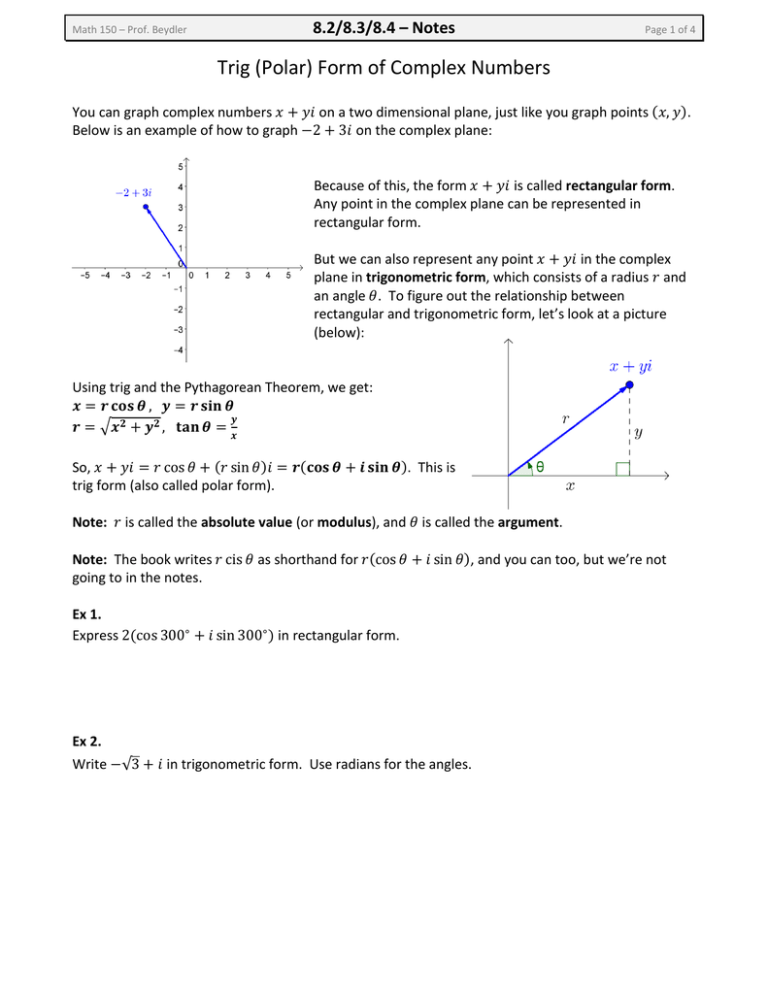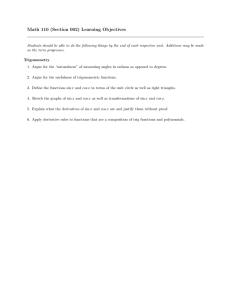Trig (Polar) Form of Complex Numbers
advertisement

Math 150 – Prof. Beydler 8.2/8.3/8.4 – Notes Page 1 of 4 Trig (Polar) Form of Complex Numbers You can graph complex numbers 𝑥 + 𝑦𝑖 on a two dimensional plane, just like you graph points (𝑥, 𝑦). Below is an example of how to graph −2 + 3𝑖 on the complex plane: Because of this, the form 𝑥 + 𝑦𝑖 is called rectangular form. Any point in the complex plane can be represented in rectangular form. But we can also represent any point 𝑥 + 𝑦𝑖 in the complex plane in trigonometric form, which consists of a radius 𝑟 and an angle 𝜃. To figure out the relationship between rectangular and trigonometric form, let’s look at a picture (below): Using trig and the Pythagorean Theorem, we get: 𝒙 = 𝒓 𝐜𝐨𝐬 𝜽 , 𝒚 = 𝒓 𝐬𝐢𝐧 𝜽 𝒚 𝒓 = √𝒙𝟐 + 𝒚𝟐 , 𝐭𝐚𝐧 𝜽 = 𝒙 So, 𝑥 + 𝑦𝑖 = 𝑟 cos 𝜃 + (𝑟 sin 𝜃)𝑖 = 𝒓(𝐜𝐨𝐬 𝜽 + 𝒊 𝐬𝐢𝐧 𝜽). This is trig form (also called polar form). Note: 𝑟 is called the absolute value (or modulus), and 𝜃 is called the argument. Note: The book writes 𝑟 cis 𝜃 as shorthand for 𝑟(cos 𝜃 + 𝑖 sin 𝜃), and you can too, but we’re not going to in the notes. Ex 1. Express 2(cos 300∘ + 𝑖 sin 300∘ ) in rectangular form. Ex 2. Write −√3 + 𝑖 in trigonometric form. Use radians for the angles. 8.2/8.3/8.4 – Notes Math 150 Page 2 of 4 Product Theorem To multiply complex numbers in trig/polar form, you multiply the 𝑟’s and add the 𝜃’s. [𝑟1 (cos 𝜃1 + 𝑖 sin 𝜃1 )] ⋅ [𝑟2 (cos 𝜃2 + 𝑖 sin 𝜃2 )] = 𝑟1 𝑟2 [cos(𝜃1 + 𝜃2 ) + 𝑖 sin(𝜃1 + 𝜃2 )] Ex 3. Find the product of 3(cos 45∘ + 𝑖 sin 45∘ ) and 2(cos 135∘ + 𝑖 sin 135∘ ). Write the result in rectangular form. Quotient Theorem To divide two complex numbers in trig/polar form, you divide the 𝑟’s and subtract the 𝜃’s. 𝑟1 (cos 𝜃1 +𝑖 sin 𝜃1 ) 𝑟 = 1 [cos(𝜃1 − 𝜃2 ) + 𝑖 sin(𝜃1 − 𝜃2 )] (cos ) 𝑟2 𝜃2 +𝑖 sin 𝜃2 𝑟2 Ex 4. Find the quotient of 10(cos(−60∘ ) + 𝑖 sin(−60∘ )) and 2(cos 165∘ + 𝑖 sin 165∘ ). Write the result in rectangular form. De Moivre’s Theorem [𝑟(cos 𝜃 + 𝑖 sin 𝜃)]𝑛 = 𝑟 𝑛 (cos 𝑛𝜃 + 𝑖 sin 𝑛𝜃) Ex 5. 8 Find (1 + 𝑖√3) and express the result in rectangular form. 8.2/8.3/8.4 – Notes Math 150 𝒏th Root Theorem 𝑛 Page 3 of 4 𝜃 The 𝑛th roots of 𝑟(cos 𝜃 + 𝑖 sin 𝜃) are given by √𝑟(cos 𝛼 + 𝑖 sin 𝛼), where 𝛼 = 𝑛 + 𝜃 𝛼 =𝑛+ 2𝜋 𝑛 ⋅ 𝑘 for 𝑘 = 0,1,2, … , 𝑛 − 1. Note that there are 𝑛 𝑛th roots. Ex 6. Find the two square roots of 4𝑖. Write the roots in rectangular form. Ex 7. Find all fourth roots of −8 + 8𝑖√3. Write the roots in rectangular form. 360∘ 𝑛 ⋅ 𝑘 or Math 150 8.2/8.3/8.4 – Notes Page 4 of 4 Ex 8. Find all complex solutions of 𝑥 5 − 1 = 0. Leave your solutions in trig form with degrees. Graph your solutions as vectors in the complex plane. Practice 1. Write −3𝑖 in trigonometric form. Use degrees for the angles. 2. Find the product and quotient of 24(cos 150∘ + 𝑖 sin 150∘ ) and 2(cos 30∘ + 𝑖 sin 30∘ ). Write both results in rectangular form. 3. Find all cube roots of 27. Leave answers in trig form with radians. 4. Find all complex solutions of 𝑥 6 + 𝑖 = 0. Leave your solutions in trig form with degrees. Graph your solutions as vectors in the complex plane. Q: A bus driver was heading down a street in Walnut. He went right past a stop sign without stopping, went the wrong way on a one-way street, and then went on the left side of the road past a cop car. The cop did nothing, because he didn't break any traffic laws. Why not?



